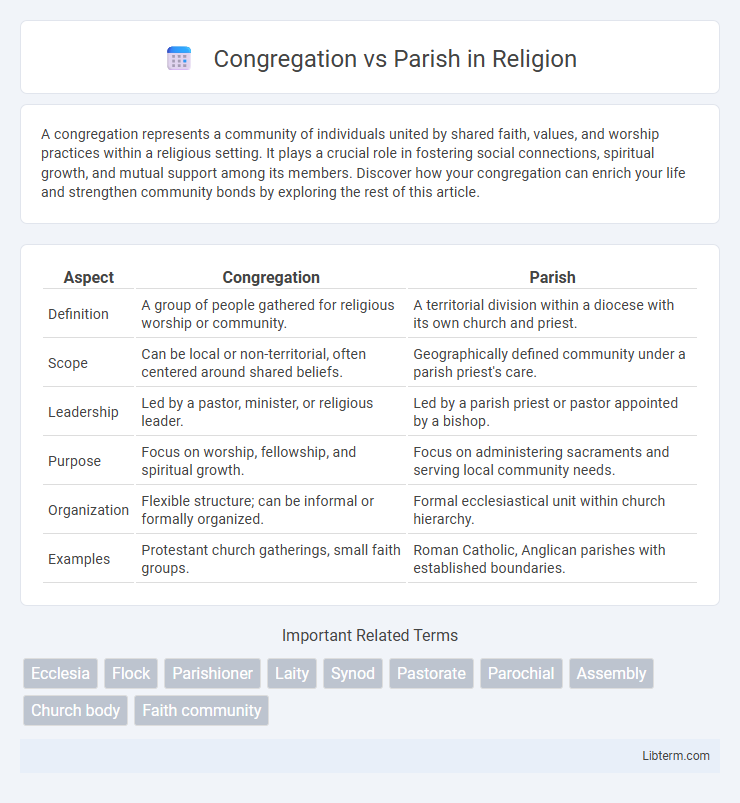A congregation represents a community of individuals united by shared faith, values, and worship practices within a religious setting. It plays a crucial role in fostering social connections, spiritual growth, and mutual support among its members. Discover how your congregation can enrich your life and strengthen community bonds by exploring the rest of this article.
Table of Comparison
| Aspect | Congregation | Parish |
|---|---|---|
| Definition | A group of people gathered for religious worship or community. | A territorial division within a diocese with its own church and priest. |
| Scope | Can be local or non-territorial, often centered around shared beliefs. | Geographically defined community under a parish priest's care. |
| Leadership | Led by a pastor, minister, or religious leader. | Led by a parish priest or pastor appointed by a bishop. |
| Purpose | Focus on worship, fellowship, and spiritual growth. | Focus on administering sacraments and serving local community needs. |
| Organization | Flexible structure; can be informal or formally organized. | Formal ecclesiastical unit within church hierarchy. |
| Examples | Protestant church gatherings, small faith groups. | Roman Catholic, Anglican parishes with established boundaries. |
Introduction to Congregation vs Parish
A congregation refers to a group of people assembled for religious worship, often within a specific church community or denomination. A parish is a territorial unit within a diocese, established by church authority, encompassing a congregation and led by a parish priest or pastor. Understanding the distinction clarifies organizational structures in Christian communities and highlights their roles in worship and local administration.
Defining a Congregation
A congregation refers to a group of individuals who regularly gather for worship and spiritual activities within a specific religious community. Unlike a parish, which is a geographic territorial unit led by a parish priest, a congregation emphasizes the communal aspect of worshippers united by shared beliefs and practices. Defining a congregation involves recognizing the collective participation in religious services, fellowship, and collective spiritual growth, independent of geographic boundaries.
Understanding the Concept of a Parish
A parish is a defined territorial unit within a diocese, serving as the local community where Catholics gather for worship, sacraments, and pastoral care under the leadership of a parish priest. Unlike a congregation, which refers primarily to the assembled members during a specific service, a parish encompasses a stable, organized community with an assigned church building and ongoing spiritual activities. Understanding a parish emphasizes its role in providing structured religious guidance, administration of sacraments, and fostering a continuous sense of community among its members.
Historical Origins of Congregation and Parish
Congregations historically emerged as distinct groups of worshippers within Protestant traditions, emphasizing local autonomy and community-based governance. Parishes originated in the early Christian Church as territorial divisions established by bishops to administer sacraments and pastoral care within a defined geographic area. The parish system became foundational in medieval Europe, aligning religious organization with local governance structures.
Key Differences Between Congregations and Parishes
Congregations typically refer to the group of individuals who gather for worship within a religious community, while parishes denote a specific geographic area served by a church and its clergy. Parishes often have formal administrative structures, including a designated priest or pastor responsible for sacramental rites and pastoral care, whereas congregations can exist within or outside parish boundaries and vary in organizational complexity. The key distinctions lie in territorial jurisdiction and governance, with parishes serving defined communities and congregations emphasizing collective worship participation.
Roles and Responsibilities: Congregation vs Parish
A congregation primarily refers to the group of individuals who regularly attend services and participate in worship, while a parish denotes a defined geographical area under the pastoral care of a parish priest or pastor. The roles within a congregation often involve active participation in church activities, spiritual fellowship, and community support, whereas parish responsibilities include administration of sacraments, pastoral care, and maintaining parish facilities. Parishes manage broader organizational duties and outreach efforts, serving as the structural and spiritual hub for multiple congregational groups within their jurisdiction.
Leadership Structures in Congregations and Parishes
Leadership structures in congregations typically include a pastor or minister supported by a board of elders or deacons who oversee spiritual and administrative duties. Parishes are often led by a parish priest or pastor, working alongside a parish council composed of elected lay members to manage church activities and community engagement. Both structures emphasize collaborative leadership but differ in organizational hierarchy and the role of lay participation within their governance models.
Geographic Boundaries and Community Involvement
A parish typically denotes a geographic area with defined boundaries serving as the primary local church community within a diocese, facilitating organized worship and sacramental activities. A congregation refers to the group of individuals who regularly attend services at a specific church, not necessarily limited by geographic boundaries but united by shared worship practices and community involvement. Parish boundaries help structure religious administration and outreach, while congregational involvement emphasizes active participation and engagement in church life regardless of residents' exact locations.
Impact on Worship and Church Activities
Congregations typically foster a more intimate and personalized worship experience, enabling active participation and stronger community bonds among members. Parishes often support a broader range of church activities, including organized ministries, outreach programs, and sacramental services, reflecting their role as an administrative and pastoral unit. The structure of a parish provides stability and resources that can enhance both worship quality and the scope of church activities beyond the immediate congregation.
Choosing the Right Community: Congregation or Parish
Choosing the right community between a congregation and a parish depends on individual spiritual needs and community involvement preferences. A congregation often refers to a specific group of people gathered for worship, usually within a particular denomination or church, emphasizing a close-knit communal experience. A parish, however, typically denotes a territorial church jurisdiction under a pastor's care, offering broader sacramental services and outreach programs that cater to families and local residents.
Congregation Infographic

 libterm.com
libterm.com